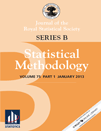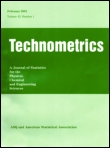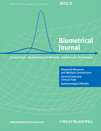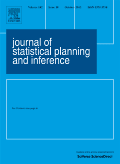
JOURNAL OF THE ROYAL STATISTICAL SOCIETY SERIES B-STATISTICAL METHODOLOGY
Scope & Guideline
Innovative Approaches to Statistical Challenges
Introduction
Aims and Scopes
- Statistical Methodology Development:
The journal emphasizes the creation and refinement of statistical methods, including Bayesian inference, high-dimensional data analysis, and nonparametric techniques. - Applications of Statistical Techniques:
A core focus is on the application of statistical methodologies to various fields such as epidemiology, economics, and social sciences, demonstrating how statistical theory can be translated into practice. - Causal Inference and Experimental Design:
The journal regularly publishes papers on causal inference, including methods for designing experiments and observational studies, which are crucial for establishing cause-effect relationships. - Data Science and Modern Computing:
With the rise of big data, there is an increasing interest in statistical methods that utilize modern computational techniques, such as machine learning and high-performance computing. - Discussion and Commentary on Current Research:
The journal includes discussions and critiques of contemporary statistical research, allowing for a collaborative exploration of methodologies and their implications.
Trending and Emerging
- High-Dimensional Data Analysis:
There is an increasing focus on methodologies specifically designed for high-dimensional data, which is prevalent in fields such as genomics and finance. This trend underscores the need for robust statistical techniques that can handle complex data structures. - Causal Inference Techniques:
Recent papers emphasize advanced causal inference methods, including those that deal with confounding variables and treatment effects in observational studies, reflecting a growing interest in establishing causal relationships. - Machine Learning Integration:
The incorporation of machine learning techniques into statistical methodology is on the rise, with researchers exploring hybrid approaches that leverage both statistical rigor and machine learning flexibility. - Functional Data Analysis:
Emerging themes in functional data analysis are evident, particularly in the context of time series and longitudinal data, highlighting the need for methodologies that can analyze data varying over time. - Personalized and Adaptive Methods:
There is a trend towards developing personalized statistical methods, particularly in health and social sciences, aimed at tailoring treatments or interventions to individual characteristics.
Declining or Waning
- Traditional Parametric Models:
There is a noticeable decrease in the publication of papers focused solely on traditional parametric statistical models, as researchers increasingly explore more flexible and robust nonparametric or semi-parametric approaches. - Basic Statistical Theory:
Papers that concentrate on foundational statistical theory without practical applications are becoming less frequent, indicating a shift towards applied methodologies that address real-world problems. - Single Methodology Studies:
Research that focuses on single statistical methods without integrating them into broader frameworks or applications is waning, as the trend moves towards interdisciplinary approaches that combine multiple methodologies. - Descriptive Statistics:
There appears to be a decline in the emphasis on descriptive statistics, as more researchers prioritize inferential and predictive modeling techniques that provide deeper insights into data.
Similar Journals

STATISTICS
Fostering innovation in the realm of statistics and probability.STATISTICS is a distinguished journal published by Taylor & Francis Ltd, dedicated to advancing the field of statistical science since its inception in 1985. With a strong focus on both the theoretical and practical aspects of Statistics and Probability, this journal serves as a vital platform for researchers, professionals, and students seeking to disseminate their findings and contribute to critical discussions in the discipline. Although categorized in the Q3 quartile for both Statistics and Probability and Statistics, Probability and Uncertainty, the journal's commitment to quality research is evidenced by its inclusion in relevant Scopus rankings. It holds respectable positions, ranked #132/168 in Decision Sciences and #219/278 in Mathematics. By providing a venue for high-quality research articles and reviews, STATISTICS aims to foster innovation, reinforce methodological advancements, and address contemporary challenges in statistical applications. The journal does not currently offer open access, but it is widely distributed, ensuring that significant research reaches the communities that need it most. Researchers are encouraged to submit their work to this essential resource that continues to shape the landscape of statistical inquiry.

TECHNOMETRICS
Transforming Data into Knowledge with Precision and RigorTECHNOMETRICS, established in 1959 and published by Taylor & Francis Inc, serves as a premier journal in the fields of applied mathematics, modeling and simulation, and statistics and probability. With its ISSN number 0040-1706 and E-ISSN 1537-2723, the journal has successfully converged over its decades-long history and is recognized for its substantial contributions to the quantitative analysis and application of statistical methods. TECHNOMETRICS is proud to maintain a distinguished reputation, ranking in the Q1 category for 2023 across its relevant fields, and positioning itself within the top 86th percentile in Mathematics _ Statistics and Probability as per Scopus rankings. While this journal currently does not operate under an open access model, it remains a crucial resource for researchers, professionals, and graduate students seeking insights and advancements in the realm of statistical methodologies and applications. Its commitment to disseminating high-quality research ensures it stands as an invaluable platform for innovation and scholarly discourse within the statistical community, making it essential reading for anyone interested in the evolution of applied statistical techniques.

JOURNAL OF BUSINESS & ECONOMIC STATISTICS
Fostering Knowledge in the Dynamic World of EconomicsJOURNAL OF BUSINESS & ECONOMIC STATISTICS is a premier academic journal published by Taylor & Francis Inc, dedicated to disseminating high-quality research in the fields of business, economics, and statistics. With an impressive impact in the academic community, the journal maintains a distinguished Q1 ranking across various categories including Economics and Econometrics, Social Sciences (miscellaneous), and Statistics and Probability, showcasing its relevance and influence in contemporary research. Since its inception in 1983, the journal has served as a vital resource for researchers, professionals, and students seeking insights into quantitative methodologies and their application in the economic domain. While the journal is not currently open access, its rigorous peer-review process ensures that published articles are of the highest scholarly standards. Researchers and practitioners alike will find a rich repository of empirical and theoretical studies that foster knowledge advancement in the intersecting realms of business, economics, and statistical analysis.

Communications for Statistical Applications and Methods
Fostering Collaboration in the World of Statistical SciencesCommunications for Statistical Applications and Methods is a vital academic journal dedicated to advancing the field of statistics, with a particular focus on practical applications and methodologies. Published by the Korean Statistical Society, this journal has become a significant resource for researchers, practitioners, and students engaged in statistical sciences and its diverse applications in various fields including finance and modeling. Operating without an Open Access format, the journal is accessible through institutional subscriptions, allowing a broad audience to benefit from its insights. The journal covers works from its inception in 2017 to 2024, and although it currently ranks in the Q4 and Q3 quartiles across various mathematical and statistical categories, its commitment to quality research makes it a noteworthy platform for emerging trends and innovations. The journal not only serves to disseminate knowledge but also fosters collaboration among statisticians, ensuring that crucial advancements in statistical applications are communicated effectively.

BIOMETRICAL JOURNAL
Connecting statistical rigor with real-world medical applications.BIOMETRICAL JOURNAL is a prestigious academic publication dedicated to advancing the fields of Medicine and Statistics. Published by WILEY since its inception in 1977, this journal plays a critical role in disseminating cutting-edge research and methodologies that bridge the gap between statistical theory and real-world medical applications. With an impressive Q1 ranking in both Medicine (miscellaneous) and Statistics, Probability and Uncertainty, it is recognized for its high-impact contributions to the scientific community. The journal actively encourages submissions that utilize innovative statistical techniques to address complex biomedical issues, making it an essential resource for researchers, professionals, and students aiming to enhance their understanding of quantitative approaches in health and medicine. Although the journal is not open access, its rigorous peer-review process guarantees the quality and relevance of published works, further establishing its significance in the academic landscape.

BIOMETRICS
Empowering Researchers with Rigorous Peer-Reviewed FindingsBIOMETRICS, published by WILEY, stands as a prestigious journal that has made substantial contributions across diverse fields, including Agricultural and Biological Sciences, Applied Mathematics, and Biochemistry. With an impressive track record from its inception in 1946 and continuing through to 2024, this journal is recognized for its rigorous peer-reviewed research and high-impact findings, evidenced by its Q1 ranking in various categories such as Medicine and Statistics. Researchers and professionals alike will find a wealth of knowledge within its pages, making it an essential resource for anyone involved in these dynamic and evolving disciplines. While BIOMETRICS does not offer open access, its reputation for delivering high-quality research ensures its continued importance in advancing the scientific ecosystem. For those seeking to stay ahead in their fields, engaging with the latest studies published in this journal is indispensable.

Journal of Statistical Planning and Inference
Empowering Research Through Rigorous Statistical InsightsThe Journal of Statistical Planning and Inference, published by ELSEVIER, stands as a significant platform within the fields of applied mathematics and statistics. With a history of rigorous scholarship since its inception in 1977, this journal provides a vital forum for researchers to share their advancements in statistical methodologies, planning, and inference techniques. As of 2023, it holds a respectable impact factor reflected in its Q2 rankings across multiple categories, including Applied Mathematics and Statistics and Probability, showcasing its influence and relevance in academic discourse. The journal is indexed in Scopus, with commendable rankings that affirm its scholarly merit, making it vital for professionals and students seeking the latest developments and research trends in statistical sciences. With a commitment to high-quality publications aimed at fostering innovation and practical solutions in statistical applications, the Journal of Statistical Planning and Inference is essential for anyone involved in empirical research and data-driven decision-making.

STATISTICAL PAPERS
Advancing the Frontiers of Statistical KnowledgeSTATISTICAL PAPERS, published by Springer, is a leading journal in the field of Statistics and Probability that has been contributing to the academic community since 1988. With an impressive track record spanning over three decades, this journal falls within the prestigious Q2 quartile in both the Statistics and Probability and Statistics, Probability and Uncertainty categories, signifying its high-quality research output. It currently ranks #92 out of 278 in the Mathematics - Statistics and Probability category and #61 out of 168 in Decision Sciences - Statistics, Probability and Uncertainty, placing it in the 67th and 63rd percentiles respectively. Although the journal is not open access, it offers a vital platform for researchers, professionals, and students seeking to disseminate their findings and stay abreast of the latest advancements in statistical methods and applications. With its commitment to the highest standards of scholarship, STATISTICAL PAPERS plays a crucial role in shaping contemporary statistical discourse and fostering innovation within the field.

Statistics in Biosciences
Exploring the Fusion of Statistics and BiologyStatistics in Biosciences is a distinguished journal published by Springer, focusing on the innovative interplay between statistical methodologies and biosciences. Established in 2009, this journal aims to provide a platform for the dissemination of cutting-edge research in statistical applications within biochemistry, genetics, and molecular biology. With an impressive impact factor and a distinguished ranking in multiple categories, including Q2 in Biochemistry, Genetics and Molecular Biology (miscellaneous) and Q3 in Statistics and Probability, it serves as a crucial resource for researchers, professionals, and students seeking to deepen their understanding of statistical applications in biological contexts. The journal is accessible through traditional subscription models, ensuring that high-quality research remains available to a wide audience. Featuring contributions that advance statistical theory and application in the biosciences, Statistics in Biosciences is committed to fostering collaboration and innovation in a rapidly evolving scientific landscape.

Statistical Theory and Related Fields
Connecting theory and practice in the world of statistics.Statistical Theory and Related Fields is a cutting-edge journal published by Taylor & Francis Ltd, dedicated to advancing the field of statistical theory and its applications across diverse disciplines. With an open access policy introduced in 2022, this journal strives to make high-quality research accessible to a global audience. Its ISSN 2475-4269 and E-ISSN 2475-4277 ensure that it is widely recognized in the academic community. The journal covers crucial topics ranked across various categories, including Q3 in Analysis and Applied Mathematics, and has a growing presence in important subfields of mathematics, as evidenced by its Scopus rankings. This positions it prominently as a valuable resource for researchers, professionals, and students seeking to explore and contribute to statistical theory and its related fields. With a commitment to fostering rigorous theoretical research, as well as practical applications, the journal plays a significant role in shaping the dialogue and advancements in statistics, probability, and computational theories.